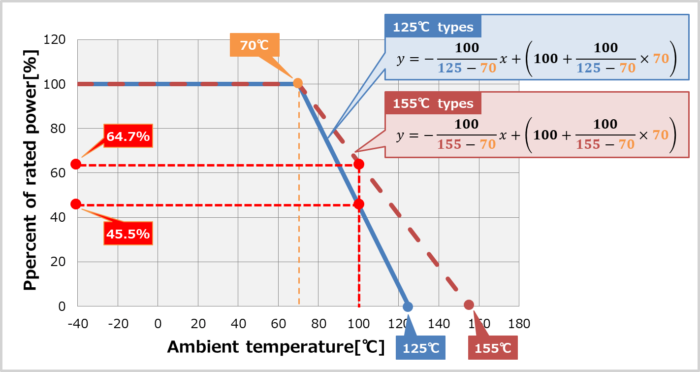Regarding the Resistor, this article will explain the information below.
- Resistor Power Derating Curve
- How to read the Resistor Power Derating Curve
Resistor Power Derating Curve

The available power of the resistor depends on the ambient temperature.
For this reason, the Resistor Power Derating Curve is included in the resistor datasheet.
The vertical axis of the Resistor Power Derating Curve is the percent of rated power, and the horizontal axis is the ambient temperature.
By looking at the Resistor Power Derating Curve, you can see how much power is available depending on the ambient temperature (we will explain how to see the Resistor Power Derating Curve later).
The Resistor Power Derating Curve is shown in the figure above. The Resistor Power Derating Curve of most manufacturers' resistors have the following characteristics
- Ambient temperature range of 70°C or less
- The percent of the rated power is 100%.
Therefore, under conditions of ambient temperatures below 70°C, 100% of the rated power can be used (which means that if a resistor with a rated power of 0.1 W is used, up to 0.1 W of power can be used).
- The percent of the rated power is 100%.
- Ambient temperature range of 70°C or higher
- The percent of the rated power decreases from 100%.
- Therefore, under conditions of ambient temperatures above 70°C, Therefore, under conditions of ambient temperatures above 70°C, the amount of power that can be used relative to the rated power will decrease. For example, if the percent of the rated power is 50%, only 50% of the rated power can be used (i.e., if a resistor with the rated power of 0.1 W is used, only up to 0.05 W can be used).
The Resistor Power Derating Curve depends on the size, shape, and material of the resistor. Generally, there are 125°C types and 155°C types. For the 125°C types, the rated power ratio becomes 0% at an ambient temperature of 125°C. For the 155°C types, the rated power ratio becomes 0% at an ambient temperature of 155°C.
Supplement
- The maximum ambient temperature at which 100% of the rated power can be used is called the rated ambient temperature. In the above figure, 70°C is the rated ambient temperature. Most resistors have a rated ambient temperature of 70°C.
- Some resistors can use 100% of their rated power up to an ambient temperature of 85°C (some resistors have a rated ambient temperature of 85°C).
- The vertical axis of the Resistor Power Derating Curve may be the ambient temperature or the temperature of the resistor itself. For most resistors, the vertical axis is the ambient temperature; if the vertical axis is the temperature of the resistor itself, the temperature must be measured to confirm the temperature because the resistor itself generates heat.
How to read the Resistor Power Derating Curve

Next, we explain how to read the Resistor Power Derating Curve.
For example, consider how many watts a resistor with a power rating of 0.1 W can use when the ambient temperature is 100°C.
Extending from the point of 100°C ambient temperature on the horizontal axis toward the vertical axis, the point where it intersects the Resistor Power Derating Curve is the usable power. Here, we will strictly solve the equation to calculate the usable power.
For the 125°C types, substituting 100 for x in the above formula yields the following value.
\begin{eqnarray}
y=-\frac{100}{125-70}100+\left(100+\frac{100}{125-70}×70\right)=45.4
\end{eqnarray}
Therefore, at an ambient temperature of 100°C, it can be used up to 45.4% of its rated power. This means that a resistor with a rated power of 0.1W can be used up to 0.1 x 0.454 = 0.0454W.
For the 155°C types, substituting 100 for x in the above formula yields the following value.
\begin{eqnarray}
y=-\frac{100}{155-70}100+\left(100+\frac{100}{155-70}×70\right)=64.7
\end{eqnarray}
Therefore, at an ambient temperature of 100°C, it can be used up to 64.7% of its rated power. This means that a resistor with a rated power of 0.1W can be used up to 0.1×0.647=0.0647W.
Supplement
- Rated power is the maximum power that the resistor can be used without failure or deterioration. When used near the rated power, the resistor will generate considerable heat. When the resistor heats up, the board on which it is mounted may be scorched or the solder may melt. Therefore, it is recommended to derate the resistors so that they are used at 30% to 50% of their rated power.
Summary
This article described the following information about "Resistor".
- Resistor Power Derating Curve
- How to read the Resistor Power Derating Curve
Thank you for reading.